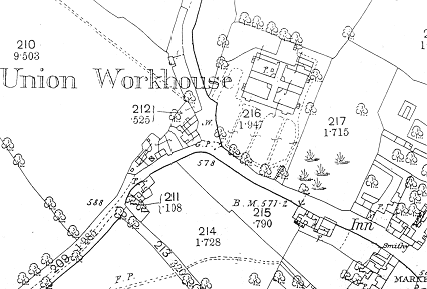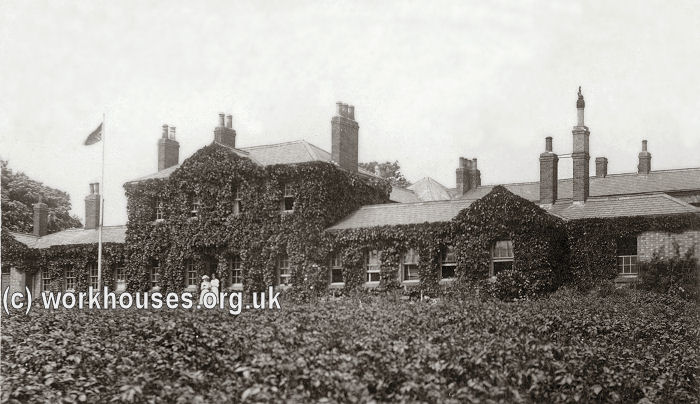Billesdon, Leicestershire
Up to 1834
Burton Overy had a workhouse from at least 1761 and in 1776 it could house up to 10 inmates. The workhouse was run by series of contractors such as Esau Pearce, a woollen manufacturer from Kibworth, who in 1806 was paid £430 a year.
There was a workhouse in Owston by 1776. In the early 1800s, the inhabitants of Owston and Newbold met to appoint the master who was to provide food, board, and employment for the inmates; his salary was £70 in 1803 and had risen to £120 by 1809.
In 1776, the Great Glen parish workhouse could hold up to 20 paupers. In 1802-3, 14 people were relieved in the workhouse while 427 vagrants also received relief from the parish. The building was located where what is now Station Lane joins the road to Newton Harcourt.
Billesdon and Houghton-on-the-Hill also had workhouses in operation by the 1770s.
After 1834
Billesdon Poor Law Union officially came into existence on 6th April 1835. Its operation was overseen by an elected Board of Guardians, 36 in number, representing its 34 constituent parishes as listed below (figures in brackets indicate numbers of Guardians if more than one):
County of Leicester:
Allexton, Billesdon (2), Burton Overy, Bushby, Carlton Curliew [Curlieu], Cold Newton, Evington, Frisby, Gaulby [Galby], Glenn [Glen] Magna (2), Goadby, Halstead, Houghton, Humberstone, Hungarton [Hungerton], Ilston-on-the-Hill, East Norton, King's Norton, Loddington, Lowesby, Marefield, Newton Harcourt, Ouston [Owston], Rolleston, Scraptoft, Skeffington, Skelton Magna, Stoughton, Stretton Parva, Tilton, Tugby, Whatborough, Wistow, Withcot [Withcote].
Later Additions: Keyham (from c.1836), Launde (from 1858), Noseley (from 1858), Stretton Magna, Thurnby (from c.1836).
The population falling within the union at the 1831 census had been 6,194 with parishes ranging in size from Whatborough and Wistow (population of 19 in each) to Billesdon itself (769). The average annual poor-rate expenditure for the period 1833-5 had been £4,820 or 15s.7d. per head of the population.
The union initially continued to make use of the Great Glen parish workhouse. In 1846, a new union workhouse was erected at the west of Billesdon with its entrance from Coplow Lane. The architect was William Parsons, of Leicester, who also designed the Blaby Union workhouse. its layout was based on Sampson Kempthorne's model "square" plan for 200 paupers published by the Poor Law Commissioners in 1836. New workhouses of this design are unusual after 1840. The front range consisted of a two-storey central block with a pedimented gable above, and with single-storey wings to each side.
The workhouse stood on a high bank above the main road and was a prominent landmark at the western end of the village. The site layout and location are shown on the 1885 map below.

Billesdon workhouse site, 1885.
During World War One, the workhouse was turned over for use as a Voluntary Aid Detachment (V. A. D.) military hospital.

Billesdon workhouse / V.A.D. Hospital from the south, c.1915.
© Peter Higginbotham.
The workhouse buildings were demolished in 1935 and the materials salvaged were used to build a row of cottages.
Staff
Inmates
Records
Note: many repositories impose a closure period of up to 100 years for records identifying individuals. Before travelling a long distance, always check that the records you want to consult will be available.
- The Record Office for Leicestershire, Leicester and Rutland, Long Street, Wigston Magna, Leicester, LE18 2AH. Holdings include: Guardians' minutes (1836-1930, with gaps); Deaths (1836-63); Creed register (1915-38); Punishment book (1854-86); etc.
Bibliography
- Higginbotham, Peter The Workhouse Encyclopedia (2014, The History Press)
Links
- None.
Unless otherwise indicated, this page () is copyright Peter Higginbotham. Contents may not be reproduced without permission.


